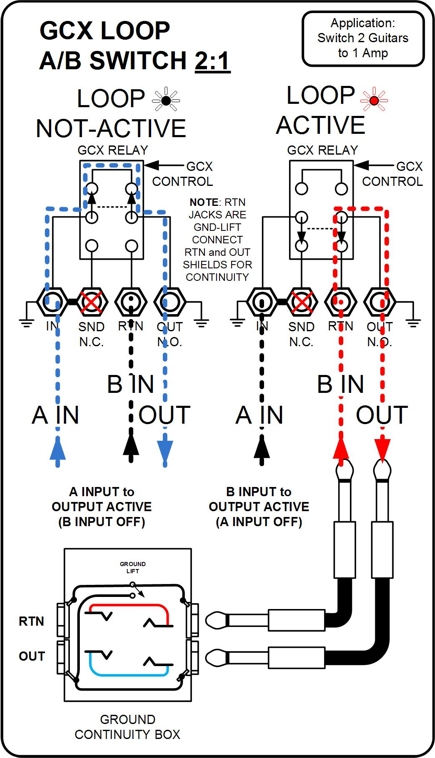FX LOOPS
A/B Switch (2 Inputs to 1 Output)(Switch 2 guitars to 1 Amp)
A/B Switch (1 Input to 2 Outputs)(Switch 1 guitar to 2 Amps)
Normally Closed Amp Switch
Normally Open Amp Switch
It helps explain what's going on inside the powerful GCX
enjoy
Joe





Hi nyteowl...nyteowl wrote:What I got from John's post is the diagram on Page 8 describes A/B switching between any two sources that share a common ground, and is not limited just to routing 2 preamps to one power amp, as well as the reason why one would want to consider using Outs as Ins and vice versa.
That final diagram has me scratching my head, though. It looks like when the loop is not active the signal exits from the Out jack and goes to the amp. So far, so good, but when the loop is active the signal is shown exiting from the Out jack, going into the Ground Continuity box, leaving the box and returning to the loop's Return jack. How does that work?
I can see how that Ground Lift switch on the Continuity Box, when in the proper position, will connect the two sleeves, but what I don't see anywhere is a source signal. As drawn, I see the Return and Out jacks forming a closed loop, so where is the guitar signal coming from?
Well, Joe, I suspect you must think I am one seriously large pain in the butt by now, but has it not already been established - as referenced on Page 8 of the manual, as well as in John's earlier post - that a break-out box is needed only if the two signal sources do NOT share a common ground? So optimally Guitar B, and not a preamp, would go to the break-out box RTN and the break-out box Out would go to a preamp or an amp, not a power amp, correct?a2dconverter wrote:Hi nyteowl...
Thanks for bringing this discussion full-circle!
Inside the Breakout Box, the Black wires are grounds...the blue and red are just feed-thrus.
(you use the RTN and OUT jacks on the Breakout box instead of the ones on the GCX)(the 1/4" cables are just jumpers)
Guitar B (or preamp B) goes to the RTN on the Break-out box and the OUT on the break-out-box is the output to the power Amp etc.
As you mentioned, the switch connects the sleeve from the OUT jack to the sleeve on the floating RTN jack.
thanks for your comments...
Regards
Joe